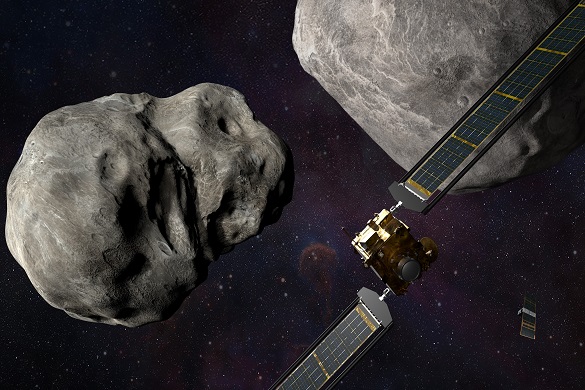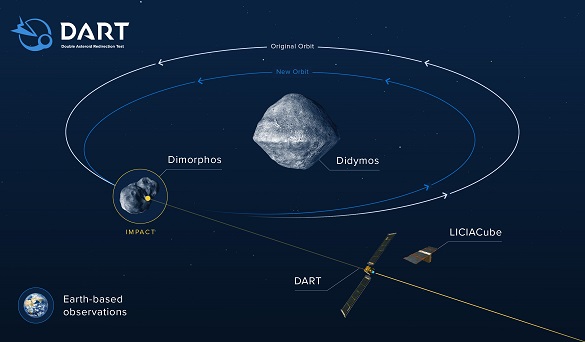
Credit: NASA/Johns Hopkins APL
A University of Liverpool engineer is providing her expertise to an historic NASA experiment taking place tonight that will see a spacecraft intentionally crash into an asteroid as part of a mission to protect Earth against deadly asteroids.
The NASA Double Asteroid Redirection Test (DART) mission will test and validate a new asteroid defection technique known as kinetic impact by deliberately colliding a simple, unmanned spacecraft into the moonlet of a binary asteroid system called Dimorphos, located 11 million km away from Earth, in order to change the object’s motion around a larger asteroid called Didymos.

Credit: NASA/Johns Hopkins APL
The DART mission is the world’s first full-scale planetary defence test, demonstrating one method of asteroid defection technology. It will also test new technologies and provide important data to enhance NASA’s modelling and predictive capabilities in order to learn more about how we might deflect an asteroid off-course to avoid it striking Earth.
University of Liverpool space engineering expert, Dr Stefania Soldini (below), is a member of DART’s Investigation Team that will be characterising, modelling and interpreting the impact of the collision with the asteroid.
She will be modelling the evolution of the ejecta particles and working on modelling the internal structure of Didymos from gravity measurements.

Dr Soldini said: “I am extremely excited to be part of this NASA mission, which is the first such mission of its kind. DART is a fascinating and mind-blowing experiment to see whether intentionally crashing a spacecraft into an asteroid is an effective way to change its course, and this could be a useful technique should an Earth-threatening asteroid be discovered in the future.
“Studying how the ejecta particles behave after impact could help us to better estimate the effect of the impact, and the gravity and composition of the Didymos system. It also adds an important piece to the puzzle of our understanding of asteroids in general.”
The test impact will take place at 00:14 on Tuesday September 27 BST (19.14 on 26 September EDT) and it will be witnessed by LICIACube, the CubeSat developed by the Italian space Agency, which was deployed from the DART spacecraft on 11 September.
Ground observations will estimate changes in the Dimorphos’ motion after impact however a thorough mapping of the two objects won’t take place until the European Space Agency spacecraft HERA arrives at the scene to survey the damage in early 2027 and confirm the asteroid’s trajectory changes. Dr Soldini is also a member of the HERA mission group.
You can watch the test impact here on NASA TV>>> https://www.youtube.com/watch?v=4RA8Tfa6Sck
Read Dr Soldini’s article on NASA DART mission for `The Conversation’ > Can we really deflect an asteroid by crashing into it? Nobody knows, but we are excited to try
Dr Soldini was recently awarded a prestigious UKRI Future Leaders Fellowship for the REMORA project – REndezvous Mission for Orbital Reconstruction of Asteroids: A fleet of Self-driven CubeSats for Tracking and Characterising Asteroids in partnership with Citadel Space Systems.
This project aims to develop a fleet of self-driven small satellites that will be sent out into the solar system to track and analyse asteroids. This will provide vital data about possible threats to Earth, helping to develop mitigation against the risk of impact.